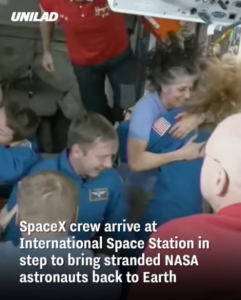In a pivotal mission underscoring international collaboration in space exploration, SpaceX’s Crew-10 successfully docked with the International Space Station (ISS) on March 16, 2025. This mission is particularly significant as it facilitates the return of NASA astronauts Sunita “Suni” Williams and Barry “Butch” Wilmore, who have been aboard the ISS since June 2024 due to unforeseen technical challenges with their original spacecraft.
The Stranding of Williams and Wilmore
Williams and Wilmore embarked on their mission in June 2024 aboard Boeing’s Starliner capsule, intending for a brief eight-day stay on the ISS. However, shortly after docking, the Starliner experienced critical thruster failures and helium leaks, rendering it unsafe for the astronauts’ return journey. Consequently, NASA made the difficult decision to bring the Starliner back to Earth uncrewed in September 2024, leaving Williams and Wilmore on the ISS for an extended duration.
The Crew-10 Mission: A Rescue Endeavor
In response to the situation, NASA and SpaceX coordinated the Crew-10 mission to facilitate the safe return of the stranded astronauts. Launched from Kennedy Space Center in Florida, the Crew-10 spacecraft carried a diverse international team: NASA astronauts Anne McClain and Nichole Ayers, Japan’s Takuya Onishi, and Russian cosmonaut Kirill Peskov. After a 29-hour journey, the Crew-10 capsule successfully docked with the ISS at 12:05 a.m. EST on March 16, 2025.
A Warm Reception and Lighthearted Moments
The arrival of Crew-10 was met with enthusiasm and relief aboard the ISS. In a display of camaraderie and humor, NASA astronaut Nick Hague greeted the newcomers wearing an alien costume, adding a touch of levity to the mission’s serious objectives. This gesture highlighted the strong bonds and morale among the crew members during extended missions in space.
Scientific Endeavors and Future Missions
During their extended stay, Williams and Wilmore continued to contribute to various scientific experiments and maintenance tasks aboard the ISS. The arrival of Crew-10 not only ensures their return but also brings fresh expertise to the station. The new crew members are slated to engage in a six-month mission focusing on scientific research, including studies on Parkinson’s disease, cancer, and the development of technologies essential for future lunar and Mars missions.
The Impending Return Journey
Williams and Wilmore, along with Crew-9 members Nick Hague and Russian cosmonaut Aleksandr Gorbunov, are scheduled to depart the ISS on March 19, 2025. Their return will mark the conclusion of an unexpected nine-month mission, significantly longer than initially planned. Despite the challenges, both astronauts have remained resilient and focused on their duties. Williams expressed her eagerness to reunite with her family and pets, acknowledging the emotional toll of the prolonged separation.
Reflections on International Cooperation
The successful execution of the Crew-10 mission underscores the importance of international collaboration in addressing unforeseen challenges in space exploration. The joint efforts of NASA, SpaceX, and international partners exemplify the collective commitment to the safety and well-being of astronauts, as well as the advancement of scientific knowledge. As space missions become increasingly complex, such collaborations will be pivotal in overcoming obstacles and achieving shared goals in the final frontier.
In conclusion, the arrival of SpaceX’s Crew-10 at the ISS represents a critical step in bringing home astronauts Williams and Wilmore after their extended stay. This mission not only highlights the challenges inherent in space travel but also showcases the resilience and unity of the global space community in ensuring the success and safety of its endeavors.


